The sculptor Agostino di Duccio was born in Florence. His earliest works were probably the reliefs (ca. 1442) carved for the Duomo of Modena. He fled from his native city in 1446, after being accused of stealing silver from a church. He worked on the Tempio Malatestiana in Rimini in ca. 1446-57. Jacopo Vannucci, who was Bishop of Rimini in 1448-9 before becoming Bishop of Perugia, might have suggested him for the important commission for the sculpture of the facade of the Oratorio di San Bernardino (see below), which kept him in Perugia for the period 1457-62.
Agostino returned to Perugia in 1473 for another important commission, the Porta San Pietro. The funerary monuments of members of the Geraldini family in Amelia are attributed to Agostino in this last phase of his career. He was documented in July 1481, in relation to a new model for the cornice of Porta San Pietro (below), and it used to be thought that he had died in Perugia shortly afterwards. However, another document that proves that he was alive in December 1481 has recently been discovered. In fact, he could have died at any date in the period to 1498, when his wife remarried.
Amelia
Funerary Monument of Giovanni Geraldini (1476)
The monument of Giovanni Geraldini was documented in the family chapel in San Francesco in 1662, and this is usually said to have been its original location. However, the composition includes a large relief of St John the Baptist, which suggests that it had originally been designed for the Cappella di San Giovanni Battista, which Giovanni had built in the Duomo a short time before 1480. The surviving elements of it, which were clumsily recomposed in this chapel at an unknown date after 1916, are attributed to Agostino di Duccio.

-
✴the relief of St John the Baptist mentioned above is at the apex of the composition;
-
✴a relief of the the Madonna and Child with three personifications of virtues is mounted on the wall below;
-
✴the effigy of Giovanni Geraldini lies on a sarcophagus that stands on the floor.
The virtues to the sides of the Madonna and Child represent Faith and Hope: the figure of the Baby Jesus presumably represents the third Theological Virtue, Love. The third personification to the right, which disturbs the symmetry, represents the Cardinal Virtue, Fortitude.
The inscription on the front of the sarcophagus reads: “CONSTRUIS ET GENERI ET TIBI GERALDINE IOHANNES PRAESUL APUD CALABROS HOC CATHACENSIS OPUS”, with the date 1476 below it. The likelihood is that this refers to both the monument and the chapel in the Duomo.
Monument to Matteo and Elisabetta Geraldini (1477)
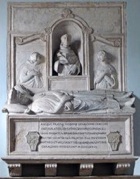
Monument of Bishop Ruggero Mandosi (ca. 1484)
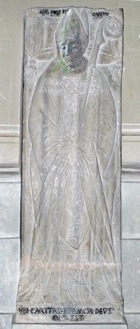
-
✴the inscription on the pillow, to either side of the mitre, reads “SPES: FIDES: CARITAS” (Hope; Faith; Charity); and
-
✴the inscription under the bishop’s feet reads “Ubi Caritas et Amor, Deus ibi est” (Where charity and love are, God is there” (which is from a hymn that is usually used on the feast of the Last Supper).
The relief is sometimes attributed to Agostino di Duccio, although (as noted above) the last documentary reference to him is in 1481, some three years before the death of Bishop Mandosi. It is of course possible that the monument was commissioned while Bishop Mandosi was still alive, and/or that Agostino di Duccio survived after the documentary evidence runs out.
It is also possible that the reliefs of Virtues now incorporated into the monument to Giovanni Geraldini (above) came from this monument.
Bettona
Crucified Christ (ca. 1470)
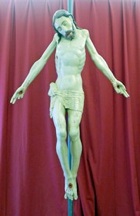
Perugia (1457-62)
Façade of the Oratorio di San Bernardino (1457-62)
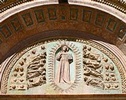

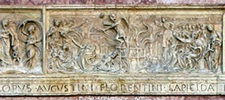
The sculpture of the façade of the Oratorio di San Bernardino is the earliest documented work by Agostino di Duccio in Perugia. The composition includes reliefs of scenes from the life of St Bernardino of Siena and figures of the Annunciation and of the patron saints of Perugia in tabernacles. Bartolomeo di Mattiolo was also associated with the work, and received a specific payment in 1458 for the tabernacle destined to house the figure of the Virgin. In fact, the execution of all four tabernacles has been attributed to him.
Most of the work on the facade is attributed to Agostino di Duccio himself:
-
✴The relief in the lunette over the double doors (illustrated to the left), which depicts St Bernardino in Glory with musical angels, is particularly fine.
-
✴The frieze above the double portal includes an interesting relief of St Bernardino's "bonfire of the vanities" (illustrated to the right), with the signature of the sculptor below.
Tombstone of Angelo del Toscano (ca. 1457)
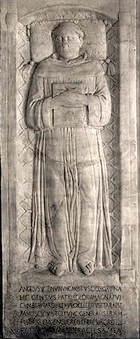
Fra Angelo was the prime mover behind the construction of the Oratorio di San Bernardino in 1451-2. His monument is usually dated to ca. 1457, after Agostino di Duccio was commissioned to work on its facade. His memorial stone was moved to this oratory in the early 20th century.
Altare di San Lorenzo (1459)
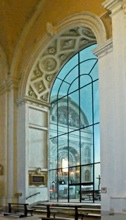
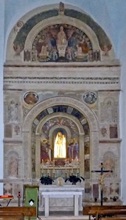
The heirs of Lorenzo di Giovanni Bello commissioned this altar in the Cappella di San Lorenzo of San Domenico from Agostino di Duccio. The contract stipulated the inclusion of statues of the Madonna and Child with SS Laurence, John the Baptist, Peter Martyr and Bridget of Sweden (respectively name saints of the deceased, his father, his grandfather and his sister). The altar was originally located on the last bay of the right wall of the nave of the church, but was demolished in 1482 to permit the construction of the Cappella di San Lorenzo. It was demolished in 1482 to permit the construction of the Cappella di San Lorenzo and partially re-erected as the altarpiece of the new chapel. The arch that now frames the entrance to the chapel probably originally framed the altar.
The altarpiece has been altered on a number of occasions. As currently reconstituted, the altar contains a number of figures that are attributed to Agostino di Duccio:
-
✴the Madonna and Child with flanking angels in the lunette;
-
✴stone figures of the Annunciation in the upper niches to the sides (which probably did not belong to the original altar); and
-
✴terracotta figures of SS John the Baptist and Laurence in the lower niches to the sides.
A marble predella panel in which Saint Bridget of Sweden receives the rule of her order, which is attributed to Agostino di Duccio and which almost certainly belonged to the original altar, is now in the Metropolitan Museum, New York.
Madonna and Child (ca. 1460)
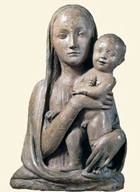
Perugia (1473-81)
Outer Facade of Porta San Pietro (1473-81)
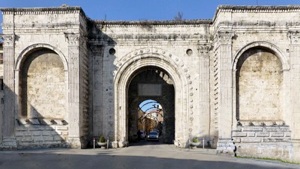
In 1458, the Commune commissioned Bartolomeo di Mattioli to build an outer facade for Porta San Pietro, in order to provide a more fitting entrance to the city. The shortcomings in this respect of the existing structure must have been evident in the following year, when Pope Pius II made his ceremonial entrance into the city. Nevertheless, very little seems to have been spent on the project by 1472, when Bartolomeo died.
In 1473, the Commune appointed three new commissioners to oversee the work (Lamberto della Corgna, Ugolino Crispolti and Carlo Cinaglia), and they commissioned Agostino di Duccio to complete the work. However, the project was subsequently redefined in more monumental terms. Agostino di Duccio signed a new and (even) more generous contract in 1475, which named Polidoro di Stefano as his associate. The works of sculpture that were envisaged for the large niches to the sides of the arch were to be the subject of a subsequent contract.
Polidoro di Stefano died in 1480, but work continued until at least July 1481, when Agostino di Duccio paid for the cornice after it had been evaluated by two Lombard craftsmen. It used to be thought that Agostino di Duccio had died in Perugia shortly afterwards and that this explained why the structure was never completed. However, as set out above, this might not have been the case. It is equally likely that the project ran out of steam after the death of Braccio Baglioni, the effective Lord of Perugia, in 1479.
The design of the outer facade betrays the influence of Leon Battista Alberti’s the Tempio Malatestiana in Rimini, in which Agostino di Duccio had worked as a sculptor some 20 years earlier. It also owes a great deal to the Arco Etrusco, a debt that would have been more evident had the planned lunette above the central arch been built.
Portal (ca. 1475)
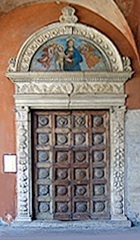
Altars in the Duomo (1473-5)
Much of the original decoration of the Duomo was done under Bishop Jacopo Vannucci who, as noted above, was Bishop of Rimini before his transfer to Perugia. The emphasis on sculpted rather than painted altarpieces at this time and the commissions given to Agostino di Duccio probably reflects his knowledge of the Tempio Malatestiana.
Altare della Pietà (1473-4)
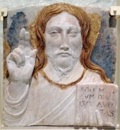
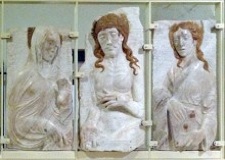
This altar, which was on the left wall of the Duomo (between the entrance to the external pulpit and the side door), was built according to the provisions of the will of Nicolò Ranieri. He named the Ospedale di Santa Maria della Misercordia as his heir on the condition that they would erect a chapel in the Duomo. The Cathedral Chapter conceded the necessary space and the Prior of the hospice duly commissioned the work from Agostino di Duccio in 1473. The documentation specified reliefs of Christ “in pietà”, between the Virgin and St John the Baptist, with God the Father above. The altar was complete by 1474, when two local sculptors pronounced it to be well-executed and worthy of its cost.
In 1625, by which time the funds to maintain the use of the altar had been exhausted, Bishop Cosimo de Torres ordered its demolition. Some fragments were recorded at the time of the apostolic visit of 1660: they were still embedded in the wall, although the surrounding structure had been demolished. Costantino Ranieri undertook their restoration in 1703, so that the altar could once more be used for services. However, it had fallen into disuse again by 1792, when it was definitively demolished.
A number of surviving fragments (including those illustrated above) were returned to the left wall of the Duomo in 1832. They were removed for restoration i [the 1990s?] The surviving fragments, which include some that were discovered only recently, were restored and placed on display in the Museo Capitolare in 2013.
Altare di San Bernardino (1473)

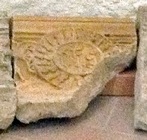
The Commune commissioned this altar from Agostino di Duccio for a chapel in the Duomo that was dedicated to St Bernardino of Siena. The altar and the dedication to St Bernardino were moved to the opposite side of the nave (the present Cappella di San Bernardino) in 1486, when the original chapel was re-dedicated to the Santo Anello. The altar was destroyed in 1559. Fragments from the arch that surrounded it are exhibited in the Museo Capitolare (Room 11). They include a relief of the sacred name of Jesus (“IHS”), which was the emblem of St Bernardino.
Madonna and Child (15th century)
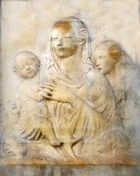
Altar (1475)
Giugliotto and Antonio Baldeschi commissioned what (judging by its cost) must have been an elaborate altar from Agostino di Duccio for their chapel at San Francesco al Prato, but this no longer survives.
Facade of the Maestà delle Volte (ca. 1475)
Surviving contracts record that Agostino di Duccio purchased stone for 14 statues for the Maestà delle Volte in 1475. These statues, which seem to have been on the facade, were dispersed after a fire destroyed the church in 1534. They began to be collected together at the end of the 19th century and entered the Galleria Nazionale over the period 1920-63. The damaged statues have been mounted in Room 19 in an arrangement that seems to reflect their original placing. The work seems to have comprised:
-


-
✴angels crowning the Virgin in the upper order (a group that includes these fragments of the Virgin and an angel); and
-
✴figures of the Apostles below (including these two, which are the only ones to retain their heads).
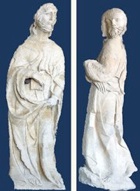
Windows of Palazzo Baldeschi Cennini (1470s)

Read more:
D. Pisani, “Piuttosto un Arco Trionfale che una Porta di Città: Agostino di Duccio e la Porta San Pietro a Perugia”, (2009) Venice
Return to Art in: Amelia Bettona Perugia.
Return to “Foreign” Sculptors in Umbria.



